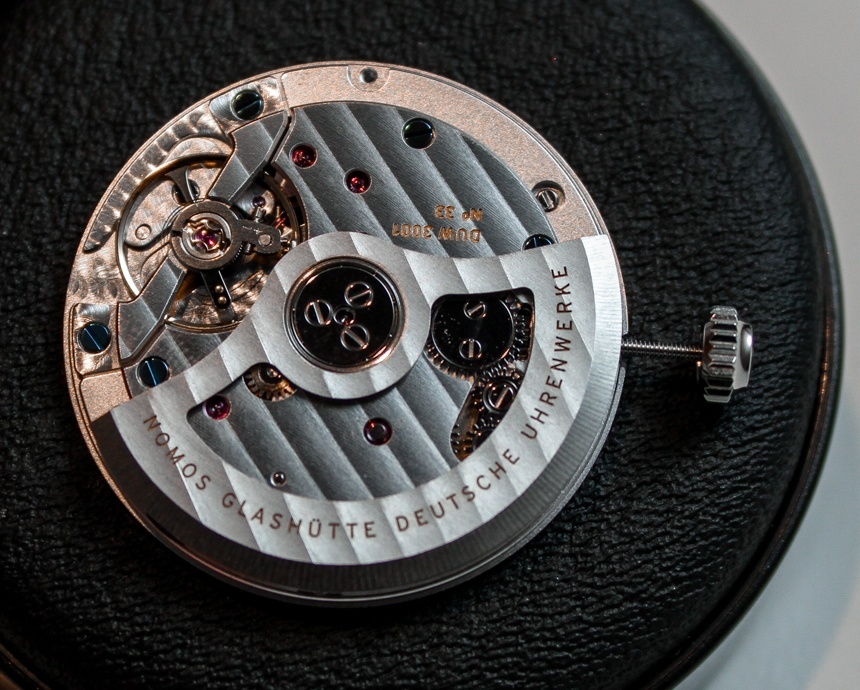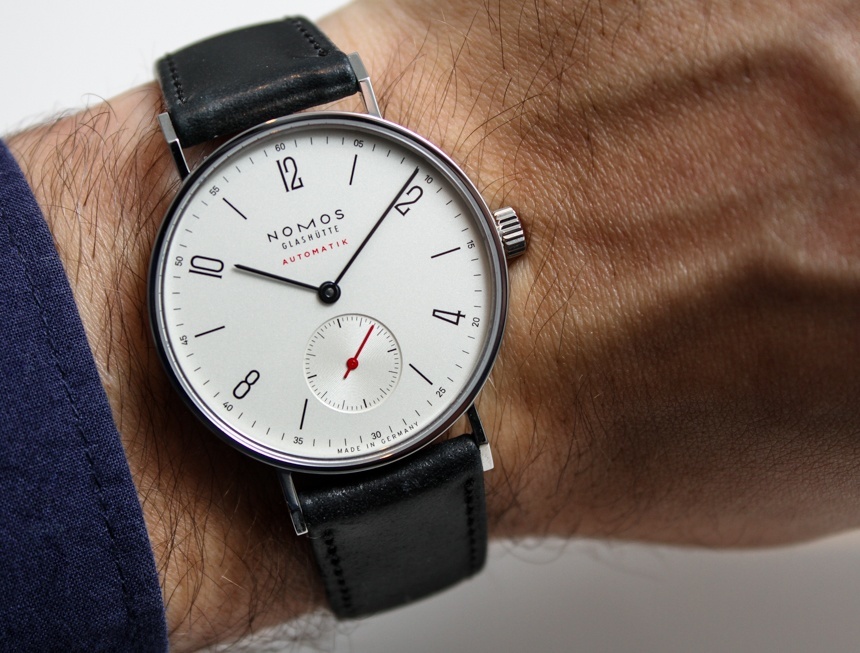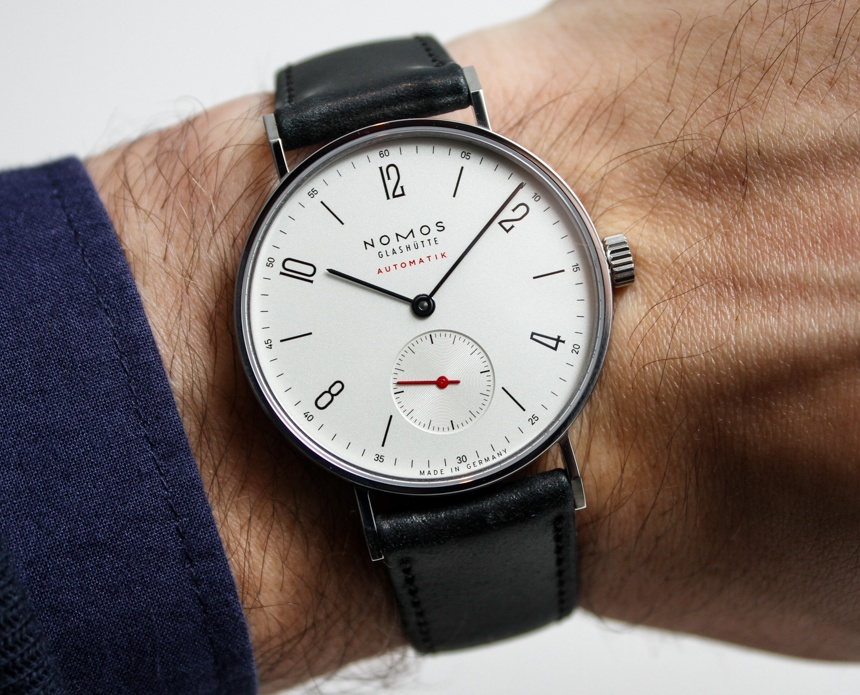
Expanding on the success of last year’s announcement of the Swing System, Nomos has upped the ante for Baselworld 2015 with a brand new automatic movement and two new watches to get that movement on your wrist. With the all-new DUW 3001, Nomos has expanded their in-house manufacture to offer a very slim and very accurate caliber with automatic winding. Initially found in two new models, the Nomos Tangente Automatik and the Nomos Minimatik, the DUW 3001 is an impressive step for this small but feisty German brand, and it’s fun to see Nomos’ core values expressed within the design and manufacturing of a new caliber that will strengthen their value-driven core line up.
The DUW 3001 Movement
This new automatic movement is the result of three years worth of development and represents far more than an update to their Epsilon calibre. Nomos’ goals with the DUW 3001 were size (it needed to be very thin), accuracy (chronometer grade), and scaled production, which would allow them to use the movement to its fullest without having to significantly raise their prices. Nomos has always offered a recognizable aesthetic, very competitive pricing, and solid technology, and the DUW 3001 will support the future of these values.
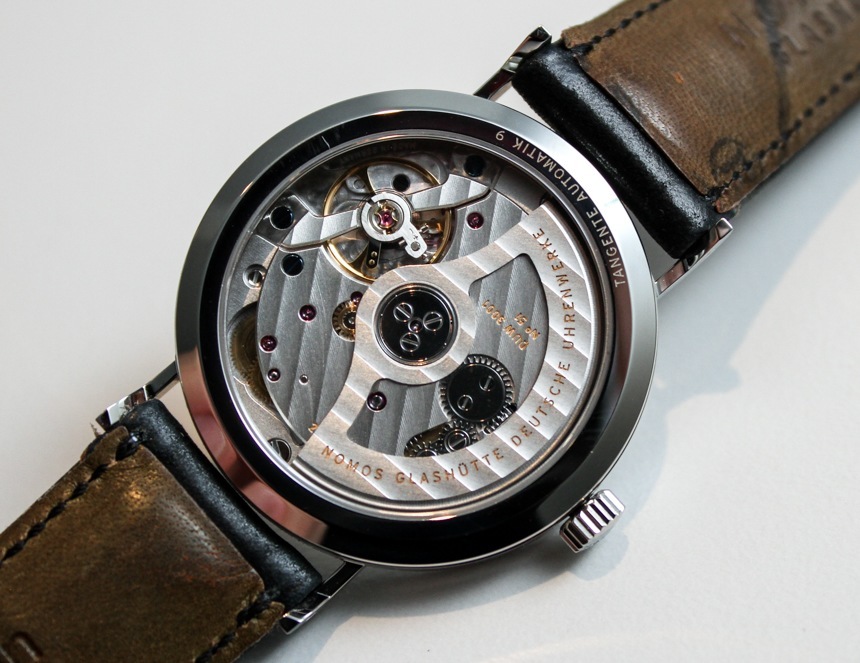
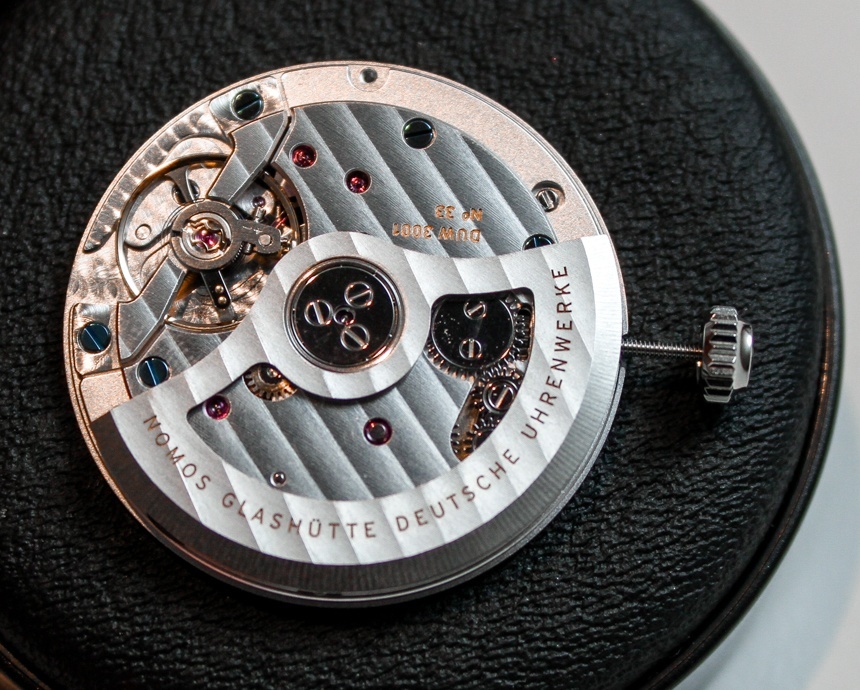 The DUW 3001 is just 3.2 mm thick, making it one of the thinner mass produced and chronometer grade automatic movements in the world. To achieve this thinness and accuracy, Nomos had to reduce their usual manufacturing tolerances by up to 50%. The DUW 3001, which was designed by Theodor Prenzel, places as many of the parts as possible between the base plate and the three-quarter plate, including Nomos’ Swing System.
The DUW 3001 is just 3.2 mm thick, making it one of the thinner mass produced and chronometer grade automatic movements in the world. To achieve this thinness and accuracy, Nomos had to reduce their usual manufacturing tolerances by up to 50%. The DUW 3001, which was designed by Theodor Prenzel, places as many of the parts as possible between the base plate and the three-quarter plate, including Nomos’ Swing System.
Core pieces like the ratchet wheel and mainspring needed to be made as flat as possible. In the case of the mainspring, flatter means less power storage, so Nomos was forced to rethink the gear train to optimize for efficiency and re-balance the effect of the flatter mainspring. This includes research into the everything from the number of teeth to the angle of each element. The result of this extreme attention? A huge increase in overall movement effectiveness and efficiency; in some cases, an increase of up to 94 percent.
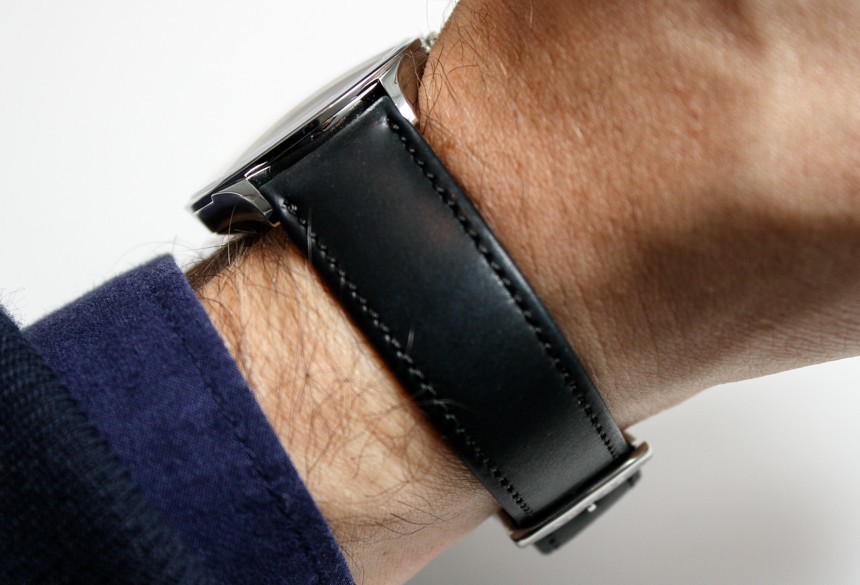 Nomos considers the DUW 3001 their next generation, an accurate and scalable automatic movement that, within the Tangente case, for example, only increases overall thickness by 0.3mm (verses the hand-wound version with the Alpha movement). The DUW 3001 is not limited, and it won’t exclusively appear within Nomos’ top tier models. Alternatively, it is ready for large scale production and will actually begin its retail life in two models with list prices around $4000.
Nomos considers the DUW 3001 their next generation, an accurate and scalable automatic movement that, within the Tangente case, for example, only increases overall thickness by 0.3mm (verses the hand-wound version with the Alpha movement). The DUW 3001 is not limited, and it won’t exclusively appear within Nomos’ top tier models. Alternatively, it is ready for large scale production and will actually begin its retail life in two models with list prices around $4000.
Running at 3Hz, the DUW 3001 is adjusted in six positions, has a power reserve of 42 hours, with bi-directional winding and incabloc shock protection. The movement will be finished to usual Nomos standards with a blue balance spring, a new Nomos balance bridge, blued screws, Glashutte ribbing, and Nomos perlage.
The DUW 3001 may be just another automatic movement, but I love the way that Nomos attempts to refine any aspect of their business. They already had the Eplison automatic movement, but they knew they could improve on the idea, apply all of their know-how, and strengthen an element at the core of their market. I also respect that they went for thinness and accuracy, two concepts that are very hard to combine, but together reflect a very Nomos ethos.
The Watches
Nomos announced two DUW 3001-based watches at Baselworld this year, the Nomos Tangente Automatik and the Nomos Minimatik. Let’s start with the Minimatic, which is the first Nomos (that I can remember) which is specifically stated as having a feminine appeal. Nomos calls the Minimatic “a women’s watch without the typical feminine characteristics”, and I would agree that this 35.5 mm three-hander is likely more feminine than the balance of Nomos’ line up. That said, it didn’t feel girly on my wrist and I don’t see any specific gender bias in most of Nomos’ line up – but I digress.
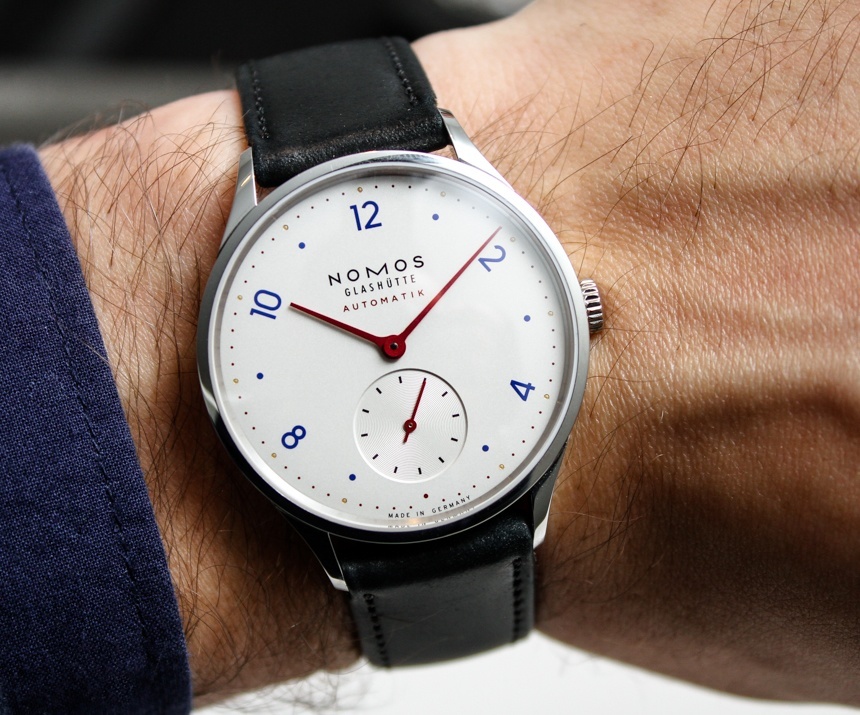 The look is almost a combination of the Club dial with an Orion case, but the case is more curved than that of the Orion and the dial more reserved (less sporty) than the Club’s. The appeal is pure Nomos, with a silver dial, blue markers and numerals, and deep red lacquered hands with a matching “Automatik” text that confirms the DUW 3001 within. The Nomos Minimatik uses a steel case with a curved sapphire top crystal and, along with the flat sapphire display case back, the total thickness is 8.6mm.
The look is almost a combination of the Club dial with an Orion case, but the case is more curved than that of the Orion and the dial more reserved (less sporty) than the Club’s. The appeal is pure Nomos, with a silver dial, blue markers and numerals, and deep red lacquered hands with a matching “Automatik” text that confirms the DUW 3001 within. The Nomos Minimatik uses a steel case with a curved sapphire top crystal and, along with the flat sapphire display case back, the total thickness is 8.6mm.
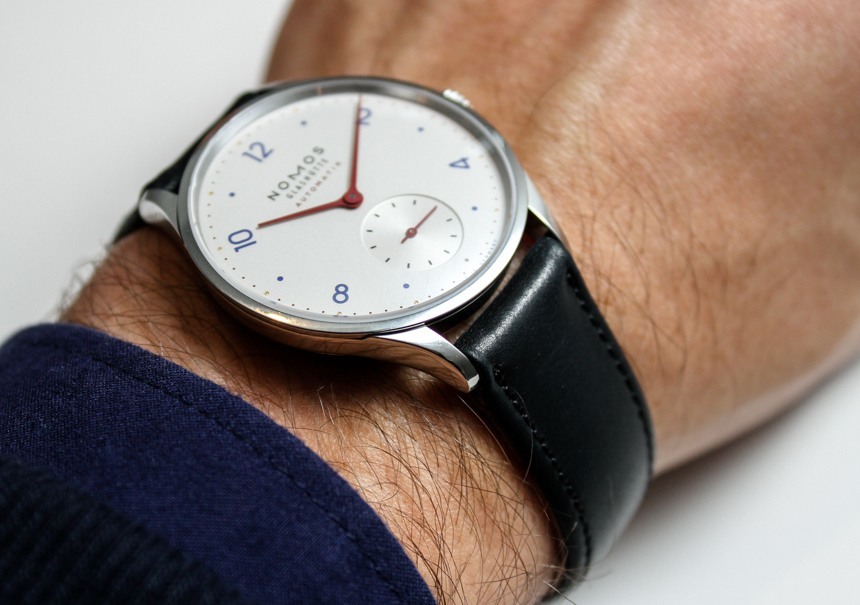
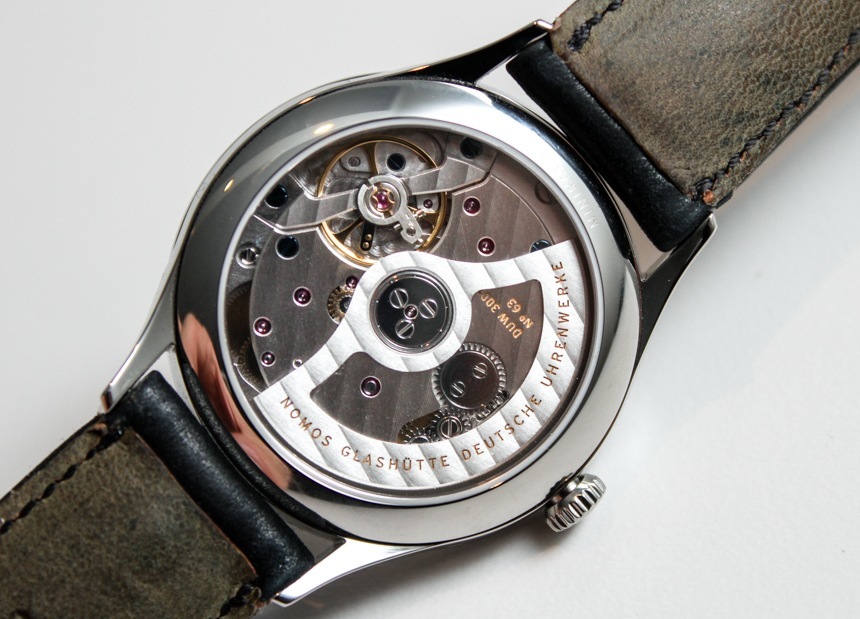 Mounted to a comfy Horween Cordovan leather strap, the Nomos Minimatik has a lovely presence that is a mix of muted colors and refined (not stark) simplicity. I really like the use of color, the blue dots for the non-numbered markers, and the choice to go without a date display, which might have spoiled the symmetry of the dial design. As with most Nomos designs, you either get it or you don’t. If you don’t, you probably didn’t read this far.
Mounted to a comfy Horween Cordovan leather strap, the Nomos Minimatik has a lovely presence that is a mix of muted colors and refined (not stark) simplicity. I really like the use of color, the blue dots for the non-numbered markers, and the choice to go without a date display, which might have spoiled the symmetry of the dial design. As with most Nomos designs, you either get it or you don’t. If you don’t, you probably didn’t read this far.
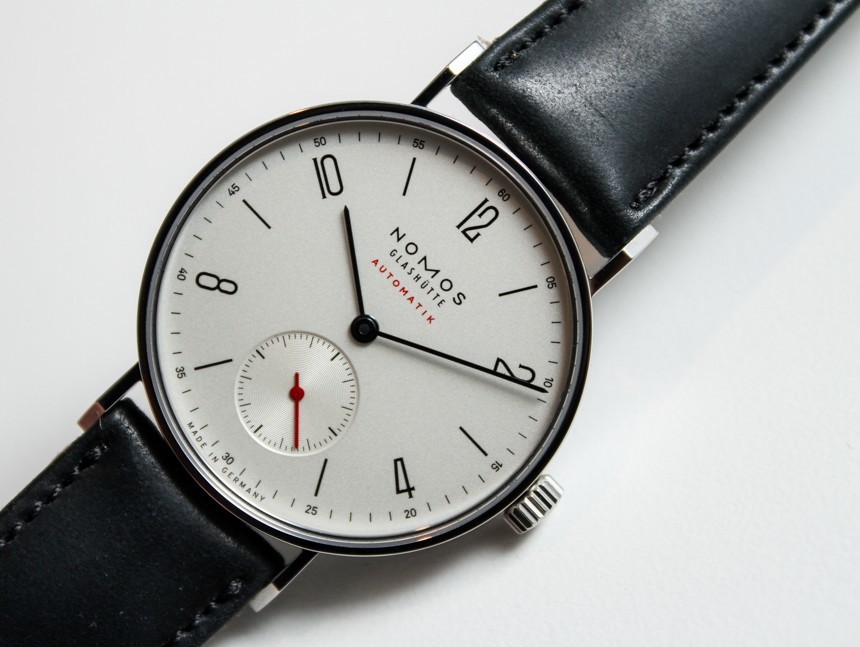
The second watch to receive the all-new DUW 3001 is the Nomos Tangente Automatik, a new version of Nomos’ award winning best seller. Originally designed in 1992, the Nomos Tangente is likely the physical icon of Nomos’ Bauhaus aesthetic. While the automatic Nomos Tangomat has been available since 2005, it has a 38mm case, which is some 3mm larger than that of the hand-wound Nomos Tangente. The Nomos Tangente Automatik, thanks to the use of the DUW 3001, maintains the very-successful 35mm sizing of the Nomos Tangente but adds automatic winding. Even in adding automatic winding, the Nomos Tangente Automatik is only 0.3 mm thicker than its hand-wound older brother, coming in at a remarkably thin 6.9 mm.
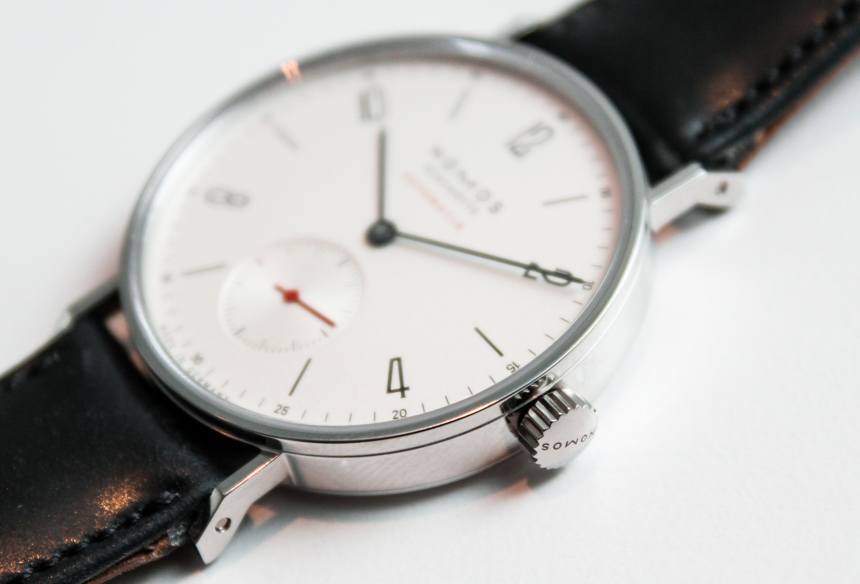
 The Nomos Tangente Automatik has sapphire crystals front and back, is water resistant to 3 ATM, and comes fitted to a black Horween Cordovan leather strap. Many of you will question the 35mm sizing, as it is considered rather small for today’s market. While I would agree that I prefer a 38 mm Nomos, their buyers definitely seem to have a hunger for the Nomos Tangente design at 35 mm.
The Nomos Tangente Automatik has sapphire crystals front and back, is water resistant to 3 ATM, and comes fitted to a black Horween Cordovan leather strap. Many of you will question the 35mm sizing, as it is considered rather small for today’s market. While I would agree that I prefer a 38 mm Nomos, their buyers definitely seem to have a hunger for the Nomos Tangente design at 35 mm.
For those of you who scoff at a 35mm men’s watch, Nomos offers many larger case sizes, from the 40mm Ahoi and Zurich Worldtimer to the 41.5mm Club Automat Datum Dunkel. Only time will tell if Nomos will update the current 38.3mm Nomos Tangomat with the DUW 3001, but it would certainly seem in keeping with their statements about the future of this new movement.
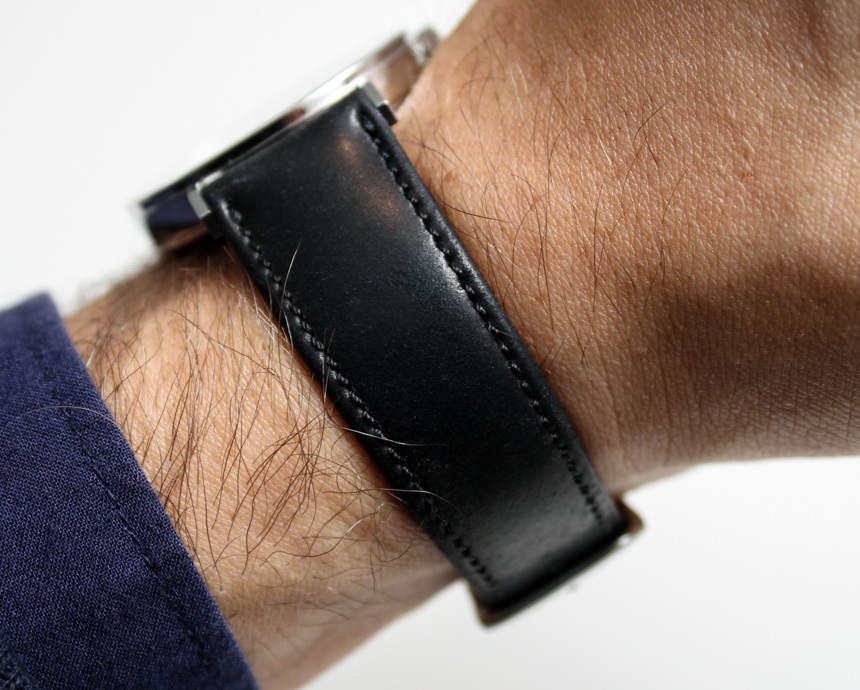 On wrist, I found the Nomos Tangente Automatic to be great. Yes, 35mm is small, but I have a couple of smaller vintage pieces and small does not equal a lesser presence. This is especially true for Nomos designs that use as much of the dial as possible and often wear larger than their case size would suggest. Just look at the on-wrist photos, the watch is small, but it’s not crazy. Within the enthusiast community, I have no doubt that 38-43mm is the range for most watches, but for Nomos, 35mm is still their bread and butter.
On wrist, I found the Nomos Tangente Automatic to be great. Yes, 35mm is small, but I have a couple of smaller vintage pieces and small does not equal a lesser presence. This is especially true for Nomos designs that use as much of the dial as possible and often wear larger than their case size would suggest. Just look at the on-wrist photos, the watch is small, but it’s not crazy. Within the enthusiast community, I have no doubt that 38-43mm is the range for most watches, but for Nomos, 35mm is still their bread and butter.
Even if you dismiss the Nomos Minimatik and the Nomos Tangente Automatik for being too small, if you’re a Nomos fan, these new models will represent great things for the brand. They are developing, growing and innovating to keep their position in the market and they have remained steadfast in offering their watches at a very reasonable price. Framed by their aesthetic, they have no competition. If you zoom way out and include vastly different brands, I could see the argument for competition from Frederique Constant, Alpina, and even Tudor. All of whom offer in-house movements that undercut the pricing of major players like Rolex and Omega.
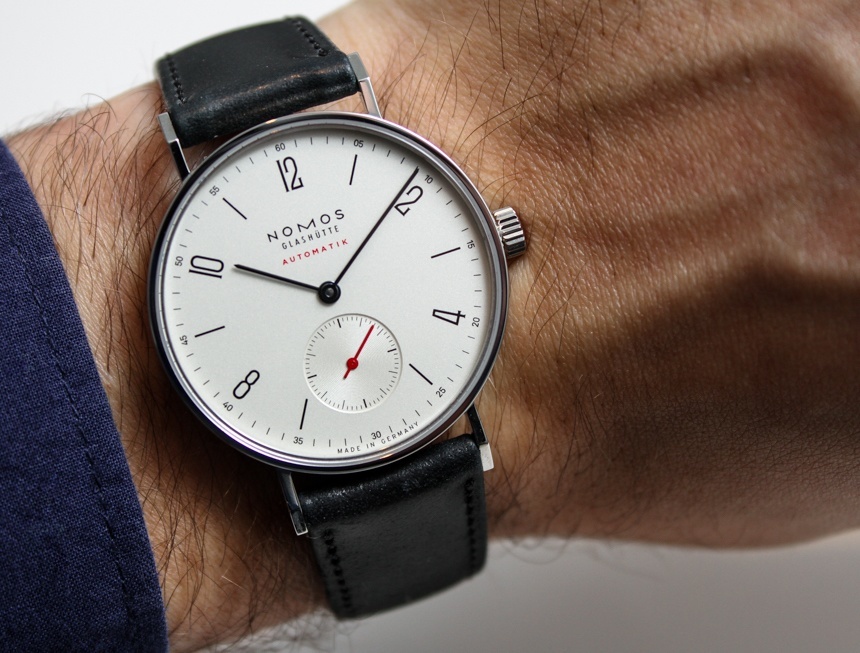 Nomos is a true enthusiast’s brand, showing up at Baselworld just as proud of a new and exhaustively-developed movement as they are of a new model or color way, and I can’t blame them. The Nomos Tangente Automatik will retail for $3780, with the Nomos Minimatik on sale for $4060. With a brand new in-house movement, a fresh option for the ladies and the proven style of the Nomos Tangente, 2015 looks like a banner year for Nomos, and we haven’t even gotten to the new Metros (stay tuned). nomos-glashuette.com
Nomos is a true enthusiast’s brand, showing up at Baselworld just as proud of a new and exhaustively-developed movement as they are of a new model or color way, and I can’t blame them. The Nomos Tangente Automatik will retail for $3780, with the Nomos Minimatik on sale for $4060. With a brand new in-house movement, a fresh option for the ladies and the proven style of the Nomos Tangente, 2015 looks like a banner year for Nomos, and we haven’t even gotten to the new Metros (stay tuned). nomos-glashuette.com

